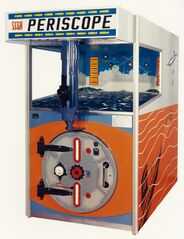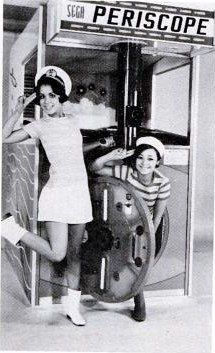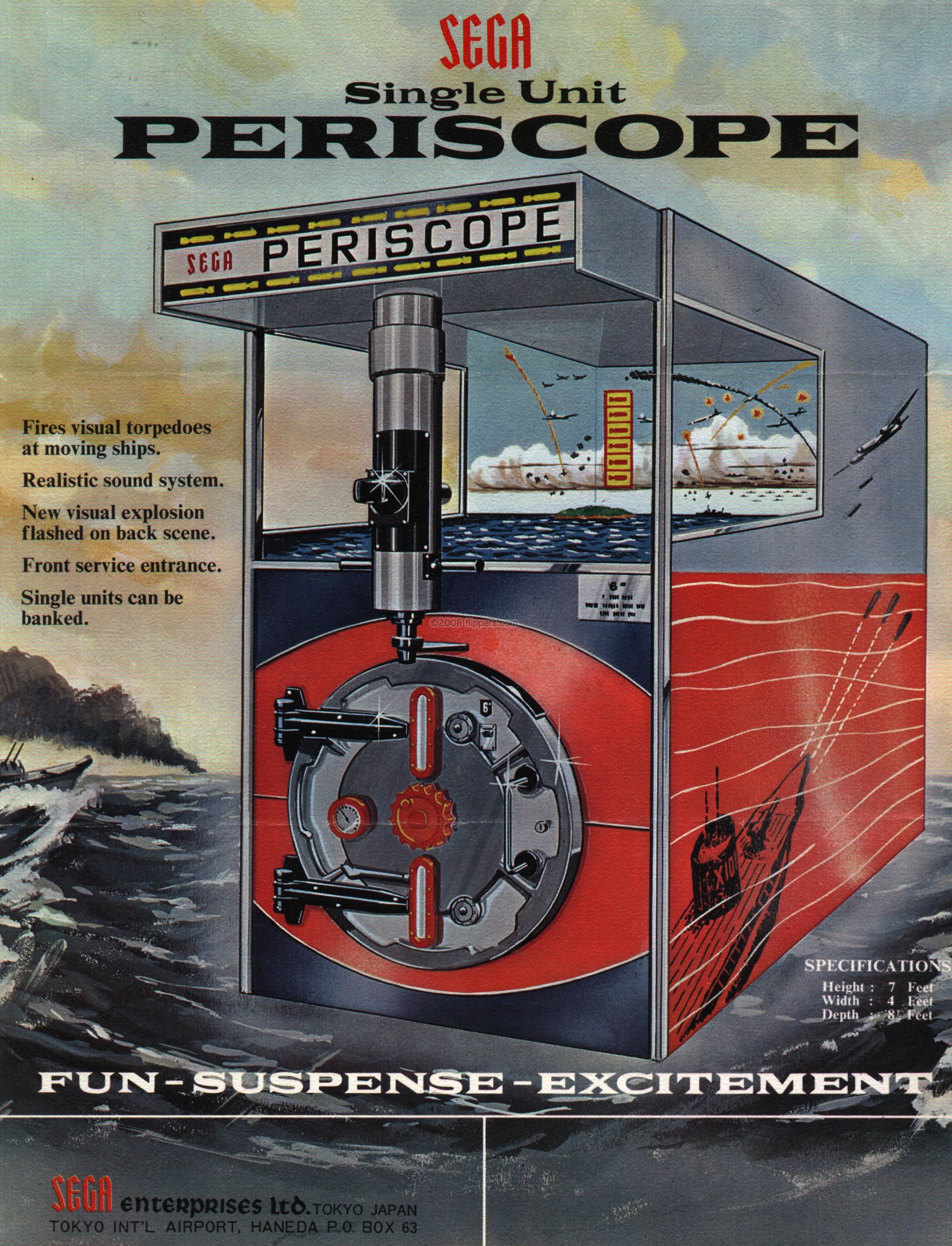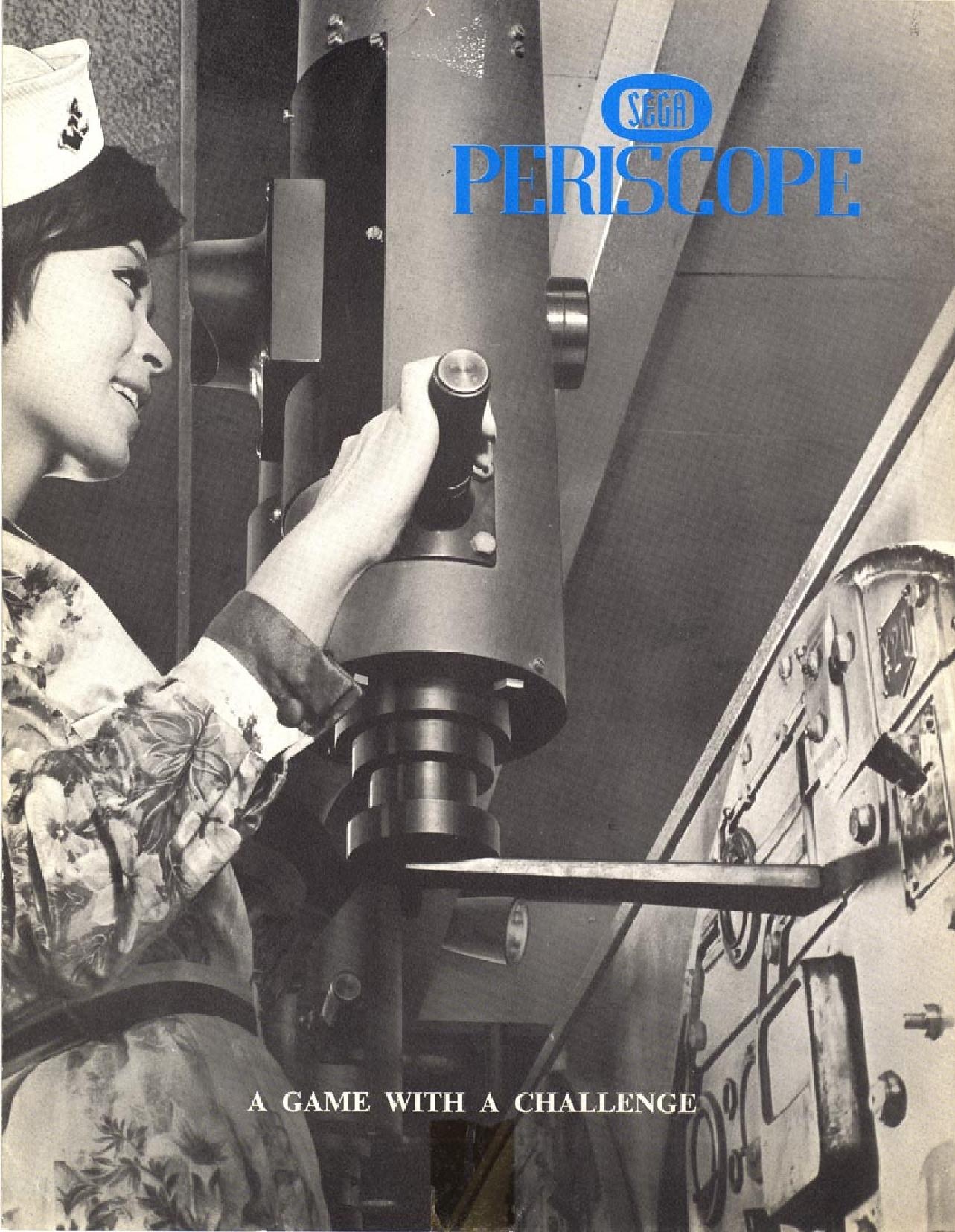Periscope
From Sega Retro

| |||||||||||||||||||||

| |||||||||||||||||||||
| Periscope | |||||||||||||||||||||
|---|---|---|---|---|---|---|---|---|---|---|---|---|---|---|---|---|---|---|---|---|---|
| System(s): Electro-mechanical arcade | |||||||||||||||||||||
| Publisher: Sega | |||||||||||||||||||||
| Developer: Namco, Sega Production and Engineering Department | |||||||||||||||||||||
| Distributor: Phonographic Equipment (UK)[1] | |||||||||||||||||||||
| Number of players: 1 | |||||||||||||||||||||
|
This short article is in need of work. You can help Sega Retro by adding to it.
Periscope (ペリスコープ) is a 1966 electro-mechanical arcade submarine game with the player looking through a periscope to shoot ships manufactured by Sega. Interior scenery inside the machine is lit up with a blacklight tube.
The game is an adaptation of an earlier Namco arcade game, also called Periscope, released in 1965. It was the first electro-mechanical arcade game to incorporate special effects and electronic sound, introducing a new genre of arcade games simulating an audio-visual experience behind a screen. Sega's version was a major milestone in the history of arcade games. It revived the North American arcade industry in the late 1960s, laying the foundation for the arrival of arcade video games in the early 1970s.
Contents
Gameplay
As the game starts boats start cruising by across the back of the scenery, and the front glass lights up "torpedoes ready to fire". Look through the periscope and aim in front of the ship, then press the fire button on the right handle. An electronic "whoosh" sounds is made as the torpedo heads towards the boat. There are a series of ten torpedo shaped lights on the playfield that make the torpedo look like it's moving towards the ship (light animation). If the boat is hit the scenery flashes a 120 volt red light from each side and an explosion is heard.
There is an electronic sound board that makes the sonor "beep" and the torpedo "woosh" sounds, and an amplifer circuit for these sounds. The explosion sound however is a mechanical sounds. It's made by pulling in a relay attached to a spring, with a magnet (to make the sound more robust) near a transducer. The spring vibrates and is read thru this phonograph needle/transducer device, like an old guitar reverb unit. A 500 mfd cap is added to the explosion relay to hold the relay in for about 2 seconds giving a longer explosion sound (if the explosion sound is too short, this cap is probably dead). This mechanical set up gives a nice explosion. The power supply for the sonar/woosh sound boards is unregulated 18 volt DC and comes from 12 volt AC to a single diode and capacitor. Adding capacitance can reduced sound hum, but will not eliminate is. It's just 1/2 wave DC regulation (not full wave like a bridge rectifier would provide), so there will always be a bit of hum.
The machine tracks how many torpedoes have been fired and how much tonnage has been sunk. The goal is to sink as many boats as you can using your torpedoes. The game gives you ten torpedoes per play with bonus torpedoes awarded for a perfect score. The boats also may change direction at any time for more challenge. There are also two windows in the front top glass that allow other people to watch the action as you play. Scoring is done with light box scoring (no score reels).
Specifications
Dimensions
Three-player cabinet
Single cabinet
History
Development
Periscope was originally a three-player machine manufactured by Namco in 1965, and was designed by its founder Masaya Nakamura.[9][10] The game was inspired by a Japanese manga series, Submarine 707 (1963–1965).[11]
The Sega version was one of the first arcade game projects to be started by the newly formed Sega Enterprises (following the merger of Rosen Enterprises and Service Games) and was engineered by Hisashi Suzuki in the same year. It was not released in Japan until 1966, however.[12]
Like Namco's version, Sega's Periscope was originally only available as a three-player game, with a single player variant entering production in early 1968.[13][14][15][16] Sega's version was exported overseas to the Western world, whereas Namco's version was only released in Japan.
Sega developed the "Model NP-3D" system to produce the "unique combination of electricity, light and sound" for the game.[17]
Impact
Periscope was an early submarine simulator and light gun shooter,[18] which used lights and plastic waves to simulate sinking ships from a submarine.[19] It was the first electro-mechanical arcade game to incorporate special effects and electronic sound.[20] It became an instant success in Japan, Europe, and North America,[21] where it was the first arcade game to cost a quarter per play,[12] which would remain the standard price for arcade games for many years to come.[21]
Periscope was the biggest hit in the history of the American arcade industry up until 1969.[22] Periscope revived the North American arcade industry in the late 1960s.[23] It popularized a new genre of "see-hear-do" arcade games,[24] where an audio-visual experience is simulated behind a screen, making it a precursor to early arcade video games.
The game was cloned by Midway as Sea Raider (1969) and Sea Devil (1970). Midway later adapted it into an arcade video game, Sea Wolf (1976).[25]
Legacy
A three-player version was advertised by Sega, taking the form of a large installation with three separate periscopes. This variant is exceedingly rare - only one is definitely known to have existed, being a setup used for the 14th Hotel Equipment Exhibition (where it stood at the Socodimex booth) in late 1967. Reportedly it was very popular, taking in 500 francs a day.
Sega Ages 2500 Series Vol. 26: Dynamite Deka replaces the Deep Scan mini-game in the original Dynamite Deka with a simulation of Periscope.
Magazine articles
- Main article: Periscope/Magazine articles.
Promotional material
Photo gallery
External links
References
- ↑ File:Periscope EM UK flyer.pdf, page 3
- ↑ Service Games: The Rise and Fall of SEGA (page 6)
- ↑ https://books.google.co.uk/books/content?id=DbFxAgAAQBAJ&hl=pt-PT&pg=PA6&img=1&zoom=3&sig=ACfU3U3dcZLsxPnbSYJZoZEE_X_yFK2MeA&w=1280 (archive.today)
- ↑ File:CashBox US 1972-02-19.pdf, page 47
- ↑ Cash Box, "December 17, 1966" (US; 1966-12-17), page 65/66 (65)
- ↑ Billboard, "November 25, 1967" (US; 1967-11-25), page 77
- ↑ File:Periscope EM US Flyer 2.pdf, page 3
- ↑ File:Periscope flyer1.jpg
- ↑ @onionsoftware on Twitter (Wayback Machine: 2017-04-18 04:11)
- ↑ Elemecha, Namco
- ↑ Who Created Periscope?
- ↑ 12.0 12.1 [Steven L. Kent (2000), The First Quarter: A 25-Year History of Video Games, p. 83, BWD Press, ISBN 0-9704755-0-0 Steven L. Kent (2000), The First Quarter: A 25-Year History of Video Games, p. 83, BWD Press, ISBN 0-9704755-0-0]
- ↑ Cash Box, "March 16, 1968" (US; 1968-03-16), page 187
- ↑ Cash Box, "July 1969" (US; 1969-07-xx), page 337
- ↑ Billboard, "September 21, 1968" (US; 1968-09-21), page 53
- ↑ Billboard, "September 21, 1968" (US; 1968-09-21), page 57
- ↑ Cash Box, "April 15, 1967" (US; 1967-04-15), page 73
- ↑ [Brian Ashcraft (2008) Arcade Mania! The Turbo Charged World of Japan's Game Centers, p. 133, Kodansha International Brian Ashcraft (2008) Arcade Mania! The Turbo Charged World of Japan's Game Centers, p. 133, Kodansha International]
- ↑ [Steve L. Kent (2001), The ultimate history of video games: from Pong to Pokémon and beyond: the story behind the craze that touched our lives and changed the world, p. 102, Prima, ISBN 0-7615-3643-4 Steve L. Kent (2001), The ultimate history of video games: from Pong to Pokémon and beyond: the story behind the craze that touched our lives and changed the world, p. 102, Prima, ISBN 0-7615-3643-4]
- ↑ Game Machine, "1983-12-01" (JP; 1983-12-01), page 17
- ↑ 21.0 21.1 [Mark J. P. Wolf (2008), The video game explosion: a history from PONG to PlayStation and beyond, p. 149, ABC-CLIO, ISBN 0-313-33868-X Mark J. P. Wolf (2008), The video game explosion: a history from PONG to PlayStation and beyond, p. 149, ABC-CLIO, ISBN 0-313-33868-X]
- ↑ Cash Box, "January 4, 1969" (US; 1969-01-04), page 36
- ↑ https://archive.org/stream/NextGeneration24Dec1996/Next_Generation_24_Dec_1996#page/n10/mode/1up
- ↑ Canadian Coin Box (April 1974), page 18
- ↑ http://www.pinrepair.com/arcade/sperisc.htm (Wayback Machine: 2020-10-13 02:17)
- ↑ http://allincolorforaquarter.blogspot.com/2015/06/the-early-history-of-sega-what-was.html (Wayback Machine: 2023-02-06 22:20)









